Travel
Lahore’s tribute to love and gastronomy
Manjula Fernando
Mughal emperor Akbar and his wife Jodha were gifted with a baby son.
Prince Salim was an ill-mannered boy. The unruly youngster was sent away
for 14 years by his father to be transformed to a disciplined adult fit
to take over the magnificent empire one day.
Main city
|

Anarkali tomb in Lahore |
At the end of a hard and long military training he was allowed to
return to the main palace in Lahore, Pakistan, the capital of the Mughal
empire. In view of the home-coming a grand ceremony was arranged. Akbar
decided to hold a great Mujra (a traditional dance performance) in honor
of his son.
A slave dancer named Nadera was chosen to perform. It was to be her
first Mujra. For her stunning beauty, Akbar name her Anarkali,
blossoming pomegranate.
According to legend Prince Salim and Anarkali fall in love. When his
father objects to the passionate affair and imprisons Anarkali the
prince rescues her and leads an army to attack the main city. The more
powerful Forces of the Emperor defeats the small army. Salim was offered
either to surrender the girl or to be killed.
Driven by his passion the prince chooses to be killed. To save her
Prince, Anarkali surrenders herself. Akbar grants her a final wish - to
spend one last night with Salim. The next day she drugs the prince with
a mixture of pomegranate juice and a secret concoction and bids
farewell.
She was taken to a place where the present day Anarkali Bazzar in
Lahore is located. Guards strap her to a wooden board, lower her into a
ditch and close the opening with a brick wall, burying her alive.
After the death of Akbar, Salim becomes the Emperor under the title
Jahangir and builds a tomb in name of Anarkali. Written on this tomb you
find the inscription “
I would give thanks unto my God unto the day of resurrection
Ah! could I behold the face of my beloved once more”
|

Anarkali and Salim |
With a mesmerizing tale behind it, the Anarkali Bazaar in Lahore, one
of Asia’s oldest surviving markets, draws many visitors. The food street
in this location is a must see for any traveler passing this grand
cultural capital of Pakistan, be it a first timer or a regular.
‘Proper waiters’
The bustling street is a spectacular view in the night with hot and
sizzling kebabs and Pakistani rotti of different shapes and sizes,
prepared fresh on wayside stoves and making their way to a platter of an
eagerly awaited to satiate the taste buds.
In keeping with its fame the street is lined with small and average
size food stalls and rows and rows of serving tables on the brick-laid
sidewalk on either side. The tourists with sensitive guts, somehow,
should be wary because the rich, aromatic food consisting of different
varieties of heavily spiced meat and ghee rice could put you into
trouble. You must either brave the risk of an upset stomach the next day
or wisely seek help from a native on mixing and matching dishes - this
little bit of advice comes out of own experience !
This colourful and buzzing street, devoid of all traffic becomes
alive with eat-outers dressed to kill as the night falls. Families with
exceptionally beautiful female members, wearing shiny sequined shalwarz
and heavy make up sit among the happy crowd waiting to be served. It was
obvious that women in Pakistan, in general, enjoy freedom and equality
as their male counterparts when you see them effortlessly mingle with
the rest of the lot.
The food lovers arriving here are sure to be served a hearty
sumptous meal by the busy restaurant-hands used to perform a multitude
of tasks; take down orders, serve and clean empty trays, explain the
dishes to tourists with an amazing rush and a ready smile.
Certain restaurants, however, do offer the services of ‘proper
waiters’, even if they are not so familiar with all the formal
etiquettes.
The cooks take their pride of place in the kitchen or the front
stove.
|

Entrance to the Food Street |
The menu of ‘Waris Tika shop’ could definitely raise some eyebrows,
especially if you have never been to a Muslim restaurant before. Among
the extraordinary dishes are Mutton brain (half or full plate), testies
(1 plate) and kidney and testies (mixed plate). Beware if you order
these, it may end up on your friend’s plate.
Food stalls
The owner of the ‘Waris Tikka’ said some food stalls and restaurants
here have been run by families for generations. But he did not inherit
his. It was brought from another businessman some years back.
The food street is known and loved for its open air dining.
Nevertheless, there are restaurants which offer airconditioned indoor
dining facilities, which is preferred by the customers during the hot
summer.
Though the street is famous for food - the literal type, the place
provides food for your soul as well. Palm readers and voodoo doctors
have their peculiar looking stands displaying human skulls and other
paraphernalia by the way side hoping to earn a living and offer relief
to the wonder seekers.
With its glittering street lights and the carnival atmosphere, the
chitter chatter of people mixed with the strong aroma of herbal spices
from food on way side stoves are ample evidence that, Lahore dispite its
own share of troubles due to heightened terror activities in recent
days, gives high esteem for social gathering and recreation.
The Food Street in old Anarkali made famous by the alluring love
story of Prince Salim and Anarkali is sure to offer you a taste of
Lahore ‘s authentic cuisine and nostalgic memories of warm hospitality.
The writer visited Karachi, Lahore, Islamabad, Rawalpindi and Muree
recently as part of a media tour arranged by the Government of Pakistan.
Mandalay - -The second capital of Myanmar
Text and Pix by Ganga Illeperuma
Mandalay the second capital city of Myanmar still retains its old
cultural traditions and is the centre of attractions for its historical
heritage. It is well-known and
|

View of Pahtodawgyi as seen from river Ayeyawady |
famous for the presence of significant
monasteries, pagodas, temples and religious edifices and also for the
Mandalay palace right in front of Mandalay Hill where the last two
Myanmar Kings, King Mindon and King Thibaw resided, a reminder to
British colonial times. Mandalay is accessible by air, rail, river and
road. Some years ago, a new international airport was completed and
Mandalay can now be reached by air directly. In fact it took only 30
minutes for our group to reach Mandalay by air.
Pahtodawgyi
It is one of the famous buildings in the world which was built by
King Bodawpaya. The building of Mingun Pahtodawgyi started in 1790. Had
it been completed it would have reached a height of some 500 feet but it
was stopped at 162 feet height. Its girth is about 450 square feet. When
he was building this temple astrologies told him ‘If you finish build
this temple you will miss the crown’. So the king stopped that
construction. The pagoda was left unfinished.
|
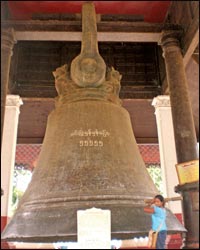
Mingun Bell |
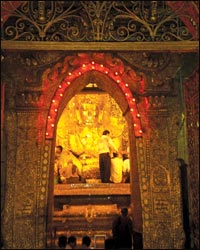
Mahamuni |
Two enormous prominent statues of lions in Mingun, one of the tourist
attractions is at the eastern stairway of Pahtodawgyi which faces the
Ayeyawaddy river. You can climb the top and from there, you can also
enjoy the natural beauty of the Ayeyawady river. If this pagoda had been
completed, then it would have been the largest monument. This unfinished
structure was damaged with cracks left by the earthquake of 1838 but it
is still the largest brick base in the world.
Mingun Bell
King Bodawpaya dedicated a big bronze bell near the Pahtodawgyi but
it is said that Buddhist devotees inserted gold, silver ornaments and
jewellery into the bronze. The Bell measures eleven cubits and four
thits (fingers) in diameter at its mouth; 33 cubits, one mit (6 inches)
and four thits in circumference and 13 cubits, one mit and four thits in
height. It weighs 55555 viss. It is the world’s biggest ringing bell.
Sinbyume
Built by King Bagyidaw in 1816 it was constructed in memory of his
oldest wife the Princess Sinbyume princess and he enshrined an emerald
shawl in it.
It is built as a representation of the Sulamani Pagoda which,
according, tothe Buddhist plan of the cosmos, stands atop Mount Meru.
The seven wavy terraces around the pagoda represent the seven mountain
ranges around Mount Meru. This pagoda was badly damaged in the 1838
quake.
Kuthodaw Pagoda
|
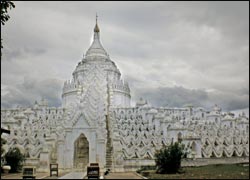
Sinbyume |
|
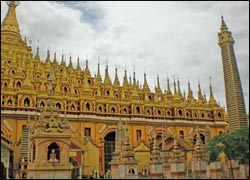
Than Buddha Pagoda |
|
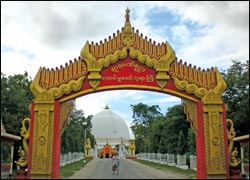
The Kaung-hum-daw |
|

The Shwe Inn Bin Monastery |
|
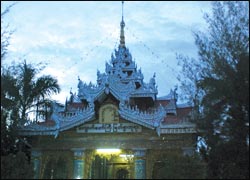
Kyauk Taw Gyi Pagoda |
The Kuthodaw Pagoda is often called the world’s largest book which
has 729 pages on stone scripts. It is a large walled complex situated at
the base of the southeast stairway to Mandalay Hill and it was built by
King Mindon in 1872.
It is in this place that the king held sangayanawa and there were
2,400 monks came from throughout the country and they completed the
pages during six months.
Kyauk Taw Gyi Pagoda
|

Mahagandar Yow |
|
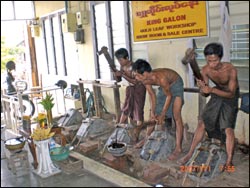
Gold Leaf workshop |
|
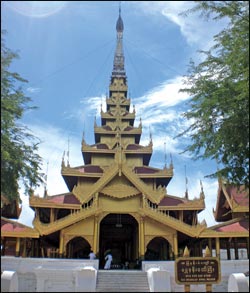
Mandalay Palace |
|

U Pein bridge |
King Mindon gained merit by having the huge Buddha image in this
pagoda carved from a single piece of white marble from the Sagyin hills
in 1853.
Here the face of the Buddha statue looks different and it has a crown
also. People who live in this area believe this Buddha image’s face is
similar to the king Mindon’s.
The Kaung-hum-daw
The Kaung-hum-daw is a large white pagoda which was built in 1636.
Inside this pagoda they enshrined a tooth relic which was presented by
Sri Lanka. Its shape is very similar to the Ruwanweli Seya in
Anuradhapura.
Than Buddha Pagoda
This temple is very similar to the Borobudur temple in Indonesia. The
famous monk who lived in this area called Monyin Sayadaw built this
temple in 1939- 1952. Inside this temple we could see 580,000 Buddha
statues and we could buy new statues and replaced them. “There are 7000
relics and many other precious materials enshrined here” said Nway U
Khine, our guide of Travelonthat accompanied us.
Mahamuni
The Maha Muni Pagoda was built to enshrine the Maha Muni image,
nearly 13 ft(4m) high. It is covered with so much gold leaf that its
body has lost all proportion. Only the face, washed during the ceremony
each dawn, is not allowed to be gilded. Women are not allowed to go near
the Buddha image.
U Pein bridge
The teakwood bridge spans 1.2 km across the shallow Taungthaman Lake
some 10km south of Mandalay.
It was built by U Pein in the mid-19th century when the capital of
Innwa (Ava) Kingdom moved to the nearby Amarapura. Today, even though a
few of the 1,000 teakwood posts have been replaced by concrete, the
bridge remains intact and serves as the main passage indispensable to
the daily life of the local people.
Mandalay Palace
Mandalay Palace was the first palace to be built in Mandalay, by King
Mindon when he shifted his capital from Amarapura in 1861. All ancillary
buildings for the court, the fortified high walls with ramparts, the
moat, water systems, roads, gardens with shady tamarind trees,
recreational playgrounds, swimming pools, security ports with infantry
and audience halls etc. The palace was burnt down during World War II by
the British and today only the city walls are original. They are 2km on
each side. The present palace is rebuilt by the military government
taking after the model of the old one. Now the palace site is occupied
by the military.
Gold Leaf
The square gold leaf tissues used for centuries and fragile enough
that a breath of the softest wind could crumble them are all hand made
in the lovely ancient capital of Mandalay. Only 24 carat gold is used.
The gold leaf is so thin and light that to smooth out wrinkles, the
girls just blowgently on it. The gold leaf is a sacred thing and can be
offered to religious buildings, and shrines or for Royal use in the days
of monarchy.
The Shwe Inn Bin Monastery
The Shwe Inn Bin Monastery was built strictly according to the rules
of monastic architecture whereas the Golden Monastery was first
constructed as a royal pavilion and has no exact monastic structure. It
is a beautiful building, well over a hundred years old, with
ancient-style doors that swing upwards.
Mahagandar Yow
This is the hermitage where over 1000 monks stay in Mandale. This was
builtin 1914 and it is very famous for its discipline. People who visit
this place can join in the alms during their lunch time. |



